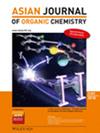6-碘-2-吡啶酮催化酯类氨解的实验与理论机理研究
IF 2.7
4区 化学
Q1 CHEMISTRY, ORGANIC
引用次数: 0
摘要
对6-卤-2-吡啶酮在酯类催化氨解中的严格评价表明,6-碘-2-吡啶酮具有很高的催化活性,特别是在苯基酯的存在下。在该反应中,一系列胺和芳香族酯以高收率得到相应的酰胺。为了阐明6-碘-2-吡啶酮催化酯类氨解的反应机理,进行了1H NMR实验、动力学研究和密度泛函理论(DFT)计算。综合结果表明,该反应是通过形成由催化剂、胺和苯基酯组成的1:1:1配合物进行的。在这种情况下,6-碘-2-吡啶酮因此作为酸碱双功能催化剂,成功地激活了酯和胺。值得注意的是,在过渡态,催化剂与苯基酯之间发生了π -π相互作用。碘的立体电子效应很可能有助于这种π -π相互作用的有利程度,促进顺利过渡到随后的苯酚的离开。6-碘-2-吡啶和6-碘-2-羟基吡啶之间互变异构化的低能垒也促进了这一过程。本文章由计算机程序翻译,如有差异,请以英文原文为准。

Experimental and Theoretical Mechanistic Study on the 6‐Iodo‐2‐pyridone‐Catalyzed Aminolysis of Esters
A rigorous evaluation of 6‐halo‐2‐pyridone in the catalytic aminolysis of esters revealed that 6‐iodo‐2‐pyridone exhibits high catalytic activity, particularly in the presence of phenyl esters. In this reaction, a series of amines and aromatic esters gave the corresponding amides in high yield. To elucidate the reaction mechanism of the 6‐iodo‐2‐pyridone‐catalyzed aminolysis of esters, 1H NMR experiments, kinetic studies, and density functional theory (DFT) calculations were conducted. The combined results demonstrate that the reaction proceeds via the formation of a 1:1:1 complex comprising the catalyst, the amine, and the phenyl ester. In this context, 6‐iodo‐2‐pyridone thus works as an acid–base bifunctional catalyst, successfully activating both the ester and the amine. Notably, a π–π interaction was observed between the catalyst and the phenyl ester in the transition state. The stereoelectronic effect of iodine most likely contributes to a favorable degree of this π–π interaction, facilitating a smooth transition to the subsequent leaving of phenol. The low energy barrier for the tautomerization between 6‐iodo‐2‐pyridone and 6‐iodo‐2‐hydroxypyridine also facilitates the process.
求助全文
通过发布文献求助,成功后即可免费获取论文全文。
去求助
来源期刊

Asian Journal of Organic Chemistry
CHEMISTRY, ORGANIC-
CiteScore
4.70
自引率
3.70%
发文量
372
期刊介绍:
Organic chemistry is the fundamental science that stands at the heart of chemistry, biology, and materials science. Research in these areas is vigorous and truly international, with three major regions making almost equal contributions: America, Europe and Asia. Asia now has its own top international organic chemistry journal—the Asian Journal of Organic Chemistry (AsianJOC)
The AsianJOC is designed to be a top-ranked international research journal and publishes primary research as well as critical secondary information from authors across the world. The journal covers organic chemistry in its entirety. Authors and readers come from academia, the chemical industry, and government laboratories.
 求助内容:
求助内容: 应助结果提醒方式:
应助结果提醒方式:


